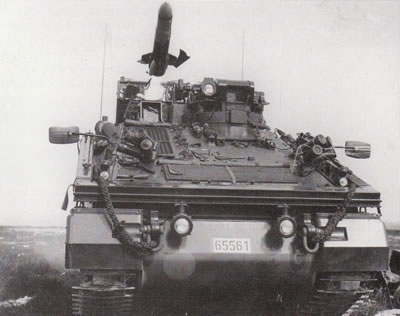
Last updated on February 17th, 2019 at 09:48 pm
The United Kingdom’s Swingfire long-range anti-tank guided missile was in service with the British army from 1969 through 2005. It was also used by the Belgian army.
It replaced the Vigilante anti-tank missile and was later replaced by the Javelin anti-tank missile.
The Swingfire long-range anti-tank guided missile had to be platform-mounted on a vehicle and fired from the vehicle. 14 Swingfire missiles could be carried on an FV432 armored personnel carrier. Two launchers would be mounted on the roof and 12 reload missiles would be held inside the APC. The launchers were reloaded and guided by MCLOS from within the vehicle.
 A cabled control unit could be used to fire the Swingfire remotely from up to 328 feet (100m) away from the vehicle.
A cabled control unit could be used to fire the Swingfire remotely from up to 328 feet (100m) away from the vehicle.
The Swingfire was also mounted on the FV102 Striker missile carrier. Ten missiles were carried. Five were placed on a roof mount, where they were ready to be launched. The remaining five were kept inside the vehicle but could not be reloaded from inside the vehicle
Other vehicles, including Land Rovers, could also be adapted to carry the Swingfire anti-tank missile.
The Swingfire weighs 81.6 pounds (37kg) and is 42 inches (1.067m) long.
It carries a HEAT warhead.
The solid fuel motor of the Swingfire long-range anti-tank missile can launch it to a range extending from 492 feet (150m) to 4,374yds (4000m).
The Swingfire is programmed to follow the center of the operator’s line of sight. The operator then uses a joystick to guide it manually. Course correction can be up to 45 degrees, if necessary.
The Swingfire can be operated in a wide range of temperatures and terrains.
